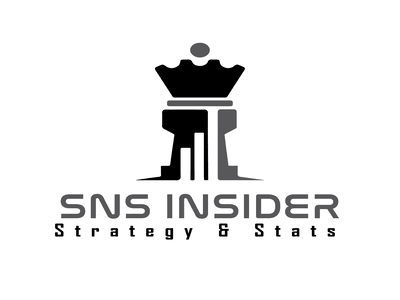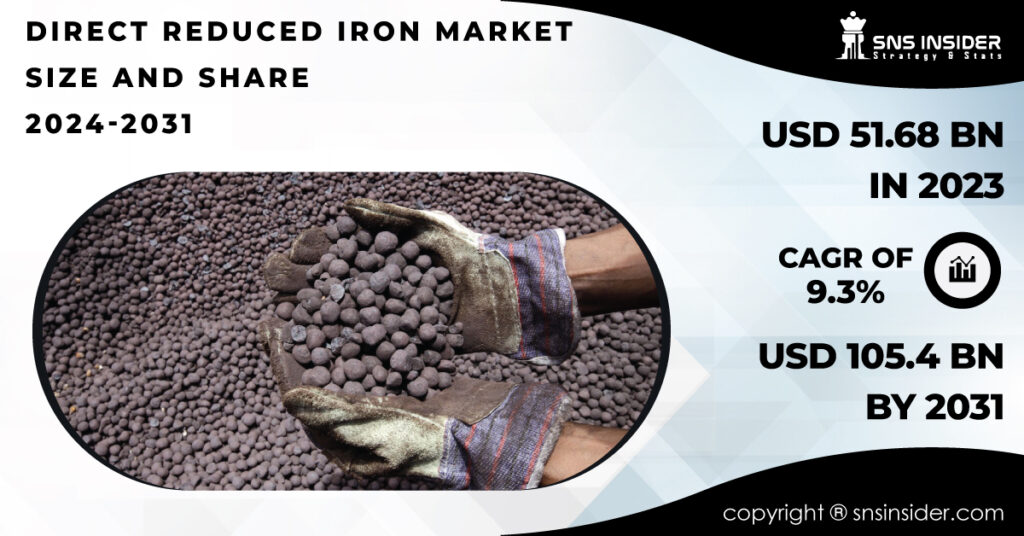
The Direct Reduced Iron Market is estimated to reach USD 105.44 billion by 2031, expanding at a CAGR of 9.3% from 2024-2031. The DRI market was USD 51.68 billion in 2023.
The shift towards DRI is fueled by the need for more sustainable steel production methods. DRI processes offer significantly reduced carbon footprints compared to traditional blast furnace techniques, making it a crucial technology in achieving environmentally conscious manufacturing. Increasing construction activities worldwide, particularly in rapidly developing regions, creates a vast demand for steel. DRI offers a superior feedstock for steelmaking processes, enhancing product quality. Additionally, the rise of electric arc furnace (EAF) steelmaking, where DRI serves as a critical input, further propels market growth. The automotive and aerospace sectors’ demand for lightweight, high-strength steel is also satisfied by DRI-based production methods. This market expansion signifies the vital role DRI plays in ensuring consistent, high-quality steel for essential applications.
Get a Report Sample of Direct Reduced Iron Market @ https://www.snsinsider.com/sample-request/3005
Some of the Key Players Included are:
- Welspun Group
- Midrex Technologies, Inc.
- Tosyali Algeria A.S.
- Voestalpine AG
- Khouzestan Steel Company
- Qatar Stee
- Hadeed Steel Industries
- Jindal Shadeed Iron & Steel LLC
- NUCOR (U.S)
- ArcelorMittal
Do You Know the Key Trends in the Direct Reduced Iron Market?
Focus on “Green” DRI: The push for decarbonization in the steel industry drives the increasing interest in DRI processes that use hydrogen as the reducing agent instead of fossil fuels. Companies are investing in R&D and pilot projects exploring various production methods.
- Perhaps the most significant recent example is H2 Green Steel. They established a DRI facility in Boden, Sweden, operating completely on green hydrogen. This plant has a massive production capacity and is slated to begin operations in 2024. It’s a landmark development in demonstrating the commercial viability of large-scale green steel production.
- In October 2022, H2 Green Steellaunched a 100% green hydrogen-powered DRI facility based on Midrex technology, representing a breakthrough in sustainable steel production.
- A collaboration between SSAB, LKAB, and Vattenfall, this project aimed to revolutionize the steelmaking process using green hydrogen-based DRI at a pilot scale. HYBRIThas already produced fossil-free steel in 2023, showcasing the technology’s potential.
Recent Developments by the key players in this industry
- May 2022: Kobe Steelintroduced “Kobenable Steel,” a low-CO2 blast furnace steel product, a first for Japan.
- March 2022: ArcelorMittalinvested USD 292 million in a dedicated electrical steel production unit, bolstering the French electromobility industry.
- February 2022: Tosyali Algeriaestablished a DRI annual production record for a single modular plant.
- March 2021: ArcelorMittal expanded its Bremen site with DRI and EAF-based steelmaking facilities.
How has the Russia-Ukraine War affected this Industry?
The conflict has created disruptions in energy markets, particularly natural gas supplies. As gas-based processes are heavily used in DRI production, this has led to price volatility and supply chain challenges for some DRI manufacturers. The conflict has also heightened the focus on reducing energy dependence within Europe, potentially accelerating the development of green hydrogen-based DRI production facilities.
Segmental Analysis:
- By Form: The pellet segmentdominated the DRI market in 2023. Pellets provide superior reactivity in steelmaking processes, offer cost advantages compared to lumps, and enjoy ease of transport and handling, making them the preferred choice.
- By Application: The steel formationsegment leads the market. This reflects DRI’s critical role in ensuring consistent, high-quality steel production, particularly as the industry seeks to utilize lower-grade raw materials in a more environmentally sustainable way.
By Form
- Lumps
- Pellets
- Others
By Production Process
- Gas-Based
- Coal-Based
By Grade
- Grade-A (Fem-81% Min)
- Grade-B (Fem-78-80%)
- Grade-C (Fem-<78%)
By Application
- Steel Formation
- Construction
- Others
Asia Pacific dominated the DRI market and held the highest revenue share in 2023
The Asia Pacific region is the largest region for the DRI market. This is fueled by booming construction activity (particularly in India), robust steel production to meet infrastructural needs and a thriving automotive and aerospace manufacturing base. Supportive government policies promoting sustainable industrial development further bolster the market in this region.
Make Enquiry About Direct Reduced Iron Market Report@ https://www.snsinsider.com/enquiry/3005
Europe also holds a significant share of the DRI market. R&D investments, along with an increasing focus on reducing the steel industry’s carbon footprint, contribute to steady market growth. Rising construction demand, driven by population growth and the need for housing, further supports the market’s expansion across the continent.
Key Takeaways for the Direct Reduced Iron Market Study
- The shift towards greener steel production is the most significant driver for the DRI market. Decarbonization efforts and a focus on hydrogen-based DRI will shape future investments and innovations.
- The overall condition of the global steel market, influenced by construction and manufacturing activity, directly affects the demand for DRI and its growth trajectory.
- Continued improvements in production efficiency, process optimization, and the ability to utilize alternative feedstocks and reducing agents will influence the market landscape.
- Geopolitical events (like the Russia-Ukraine war) and broader economic trends can create both challenges and potential long-term opportunities for the DRI market.

Table of Contents – Major Key Points
- Introduction
- Research Methodology
- Market Dynamics
- Impact Analysis
- COVID-19 Impact Analysis
- Impact of Ukraine- Russia war
- Impact of ongoing Recession
- Value Chain Analysis
- Porter’s 5 Forces Model
- PEST Analysis
- Direct Reduced Iron Market Segmentation, By Form
- Direct Reduced Iron Market Segmentation, By Production Process
- Direct Reduced Iron Market Segmentation, By Grade
- Direct Reduced Iron Market Segmentation, By Application
- Regional Analysis
- Company Profiles
- Competitive Landscape
- Use Case and Best Practices
- Conclusion
Buy the Latest Version of Direct Reduced Iron Market Report 2024-2031 @ https://www.snsinsider.com/checkout/3005
About Us:
SNS Insider is one of the leading market research and consulting agencies that dominates the market research industry globally. Our company’s aim is to give clients the knowledge they require in order to function in changing circumstances. In order to give you current, accurate market data, consumer insights, and opinions so that you can make decisions with confidence, we employ a variety of techniques, including surveys, video talks, and focus groups around the world.
Information contained on this page is provided by an independent third-party content provider. Binary News Network and this Site make no warranties or representations in connection therewith. If you are affiliated with this page and would like it removed please contact [email protected]



Comments